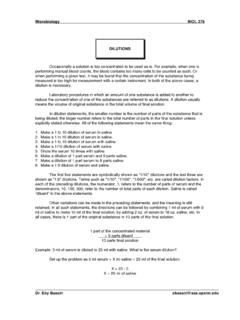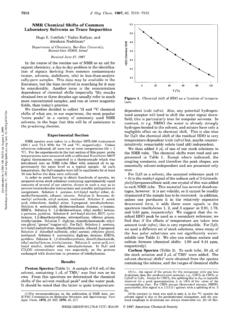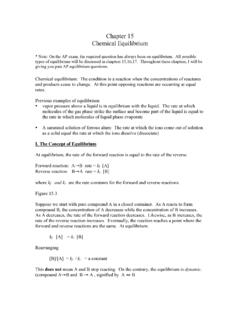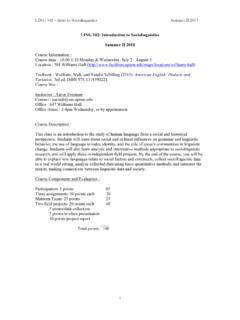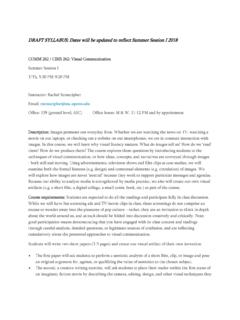Transcription of STAINING OF BACTERIAL CELLS Objective Introduction
1 molecular biology of life laboratory BIOL 123 Dr. Eby Bassiri 1 STAINING OF BACTERIAL CELLS Objective To learn the techniques of smear preparation, Gram STAINING , nigrosin STAINING and correlating the results of Gram STAINING with KOH test. Introduction Observation of bacteria with conventional bright field microscopy yields relatively little useful information. This is because of the lack of contrast coupled with the small size of the BACTERIAL cell. The use of stains that react chemically with cell material will enhance the contrast between the cell and the background.
2 A stain is a dye consisting of a colored ion (a chromophore) and a counter ion to balance the charge. Attachment of the chromophore part of the dye complex to a cellular component represents the STAINING reaction. Depending upon the dye, the chromophore can be either positively charged (cationic) and have an affinity for negative ions or negatively charged (anionic) with an affinity for positive ions. Bacteria carry a net negative charge at pH 7. Therefore, cationic dyes such as methylene blue, basic fuchsin, or crystal violet are useful for the direct STAINING of CELLS , whereas anionic stains, such as eosin and nigrosin, will not directly stain BACTERIAL CELLS .
3 However, negatively charged stains, are useful for revealing the outlines of BACTERIAL CELLS ; anionic dyes stain the background, leaving the BACTERIAL CELLS clear and bright against a dark background. Simple STAINING implies the use of only a single stain, which is usually sufficient to reveal the morphological features of most microbial CELLS , including relative size, shape, and characteristic arrangements for groups of CELLS . To obtain additional information, various specialized differential STAINING procedures have been developed. Stains that react differently with different cell types are known as differential stains, and they have an important role in the identification of taxonomic groups.
4 The most important and widely used differential stain for bacteria is the Gram stain. On the basis of their reaction to the Gram stain, bacteria can be divided into two groups: Gram positive and Gram negative. The differential response to the Gram stain is based on fundamental differences in the cell wall structure and composition of CELLS . In a manner quite similar to the Gram stain, the acid-fast stain differentiates an important group of bacteria, the mycobacteria, on the basis of lipid content of their cell wall. In the Gram stain, CELLS from a culture are spread in a thin film over a small area of a slide, dried, and then fixed by heating or with a chemical fixative to make the CELLS adhere to the glass slide.
5 A good smear preparation (1) will be of an appropriate thickness to view individual CELLS , (2) will withstand repeated washing during STAINING ; and (3) will retain the original cell morphology after fixation and STAINING . The slide is then stained with crystal violet dye, which is rinsed off and replaced with an iodine solution. The smear is then decolorized with a solution of ethyl alcohol and acetone and counterstained with safranin. In Gram positive organisms the purple crystal violet stain, treated with iodine solution, is not removed by the decolorizer solution and thus the organisms remain purple.
6 On the other hand, the purple stain is removed from Gram negative organisms by the decolorizer and so the colorless CELLS take up the red color of the safranin counterstain. molecular biology of life laboratory BIOL 123 Dr. Eby Bassiri 2 After you have stained your BACTERIAL smears, you will examine them with the oil immersion lens, noting the morphological and STAINING characteristics of each species. The usual bacteria which you will see range in size from to nearly 10 microns (A few species are many times that long.) The bacteria may show the following shapes: spherical (coccus), rod-shaped (bacillus), curved (comma), or helical (spiral).
7 After cell division, the CELLS may assume a characteristic arrangement: some occur singly, as do most Gram negative rods; others frequently appear in pairs, as in Klebsiella pneumonia, Streptococcus pneumoniae, and in the Neisseria genus. Still others occur in chains, as in the Bacillus and Streptococcus genera; in irregular clumps, as in Staphylococcus; in regular cubical packets of four or eight CELLS as in some Micrococcus species; and lying side by side or at sharp angles as in a palisade or a Chinese character as in Corynebacterium species. The differential Gram stain gives additional information about the BACTERIAL cell wall, which may be Gram positive (the deep purple color of crystal violet), or Gram negative (the pink color of the counterstain safranin).
8 This difference in STAINING reflects a fundamental difference in chemical composition of the cell wall and in the ultrastructure of the wall as revealed in electron microphotographs. The Gram negative organisms lose the primary stain after decolorization, and after counterstaining with safranin they appear pink. If Gram positive CELLS are not treated with the iodine mordant after primary STAINING , they too will lose their primary stain at the decolorizing step and appear as Gram negative CELLS . Several factors may affect the results of Gram STAINING : If the smear is too thick, proper decolorizing will not be possible.
9 If the smear is overheated during heat fixing, the cell walls will rupture. Concentration and freshness of reagents may affect the quality of the stain. Washing and drying of the smear between steps should be consistent. Excess water left on the slide will dilute reagents, particularly Gram's iodine. Gram stain is reliable only on CELLS from cultures that are in the exponential phase of growth. Older cultures contain more ruptured and dead CELLS . CELLS from old cultures may stain Gram negative even if the bacteria are Gram positive. At this time the exact mechanism of the Gram stain reaction is not yet known.
10 The most prominent current theories are as follows: (1) The cell wall of a Gram positive bacterium is composed of a heteropolymer of amino acids and sugars called peptidoglycan. This wall provides a barrier through which the crystal violet-iodine complex cannot pass during decolorization. When this wall is removed enzymatically with lysozyme, Gram positive CELLS no longer retain the stain complex and become Gram negative. A Gram negative bacterium contains less peptidoglycan and more lipid than a Gram positive organism. These chemical characteristics cause more effective and rapid removal of dye complex when decolorizer is applied.
